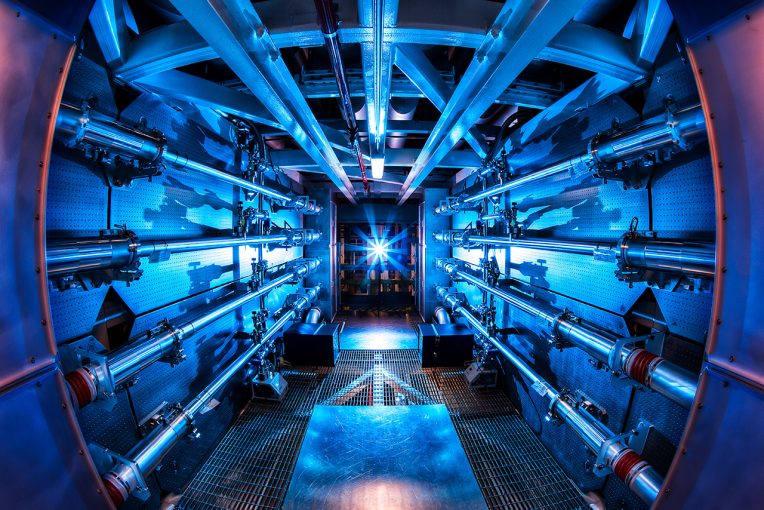On Tuesday, December 13, the United States Department of Energy announced a breakthrough in nuclear fusion technology. For the first time, scientists created more energy than what was used through a fusion ignition. This milestone was critical for scientists as they strive to innovate further advancements in nuclear technology.
Following the announcement, Illinois State University Assistant Professor of Physics Dr. Matt Caplan shared his expertise on the subject and its implications. A theoretical physicist, his research uses large-scale computer simulations to study high-density plasmas in stars similar to those in fusion experiments.
The below conversation has been edited for clarity.
Let’s start with a basic one: What is nuclear fusion?
The only time you encounter the word fusion in your daily life is at restaurants, but it means putting things together. In the case of nuclear fusion, it is the assembly of light nuclei, especially hydrogen and helium, into slightly heavier elements, which releases energy. This is the same reaction that happens in the center of our sun. Hydrogen is combined with other hydrogen to make helium. Fusion is why stars shine. This reaction liberates an enormous amount of energy, factors of a million times more energy per particle than any chemical reaction or combustion reaction. You have much more energy per amount of fuel.
What is the significance of this scientific breakthrough?
The experiment was done at the National Ignition Facility (NIF) at Lawrence Livermore National Lab. The facility is some 20 years old, this National Ignition Facility, and it is a huge honkin’ beast of a machine. Like take CEFCU Arena and make that into a single giant physics experiment.
So how this works is that they take a pellet the size of a grain of rice or a peppercorn, and in very coarse terms, you shoot 100 superpowered lasers at it. This causes it to get so hot on the surface that it implodes, reproducing conditions that only exist in stars or in nuclear weapons. The pressure is so high, and the density is so high, that these particles overcome their electric repulsion. The nuclei are all positively charged and get close enough together to fuse, which releases energy.
What the scientists have succeeded in doing is getting more energy from the fusion reactions happening in their pellet than they spent on the laser to heat it up. If you’re spending more than you’re getting out, you don’t have a viable pathway to a commercial product, right? But if you have a net energy gain, which is what they’re reporting, that would be the first big milestone toward commercial power.
What kind of impact could this mode of energy production have on our lives?
It takes a train car of coal to power a block of houses for a year. With fusion, you can get the same energy from a thimbleful of fuel pellets, no bigger than a few grains of rice. Now I want you to imagine that because it is not fission power, the breaking up of uranium, you are not generating all the spent fuel in the process. Your spent fuel is just harmless nuclei and are not radioactive nuclei themselves.
There is not a massive storage problem of spent fuel. Your fuel is more energetic per reaction and it’s clean green energy, basically indefinitely because hydrogen is everywhere. That is the very future-forward-looking goal that people have had since the 1950s.
How does this kind of energy production aid in the fight against climate change?
If you are a fusion physicist, you live in a world that has been beset by setbacks, major unanticipated technological and technical hurdles. There are a lot of different challenges with nuclear fusion: laser physics, fuel fabrication, material science, everything. If only we understood everything, we could just do fusion.
If you want to keep your funding, you say, “Yeah, we’re gonna fight climate change with this.” Unfortunately, we’re not going to be building community commercial fusion power plants between now and the 2030s, when you need to hit your targets to prevent the worst outcomes from climate change. It’s important to remember that NIF is a physics experiment, not a power plant.
What are some of the next steps you expect researchers to take?
I want to emphasize this is a milestone—but in the quite literal sense that a milestone is just a thing that you pass when you’re on a path. They have succeeded in this experiment of getting more energy out than they put in, but that doesn’t mean they’ve optimized their design yet. So, they have a formula now, but who is to say that it is the winning formula? This really opens the door to all sorts of experiments for them to tweak the knobs and refine further.
There is a massive commercialization problem, which is so far beyond the scope of anything that happened this month or was announced today. If you want to be using an inertial confinement facility for commercial power, you are taking lasers and you are blasting one of these pellets every second and putting out tons of energy. How are you collecting that? How are you not destroying the reaction chamber where this is happening?
I should emphasize; these are not prone to Chernobyl-type meltdown events. When you have a pellet, you’re only using a stick of dynamite worth of energy at any time. You’re not building a mobile bomb like the one Bane steals in The Dark Knight Rises.
I also must emphasize the size of these facilities that do this. They are enormous facilities. Miniaturization, anything they can do to get those down to a reasonable size, will be a big step forward.


